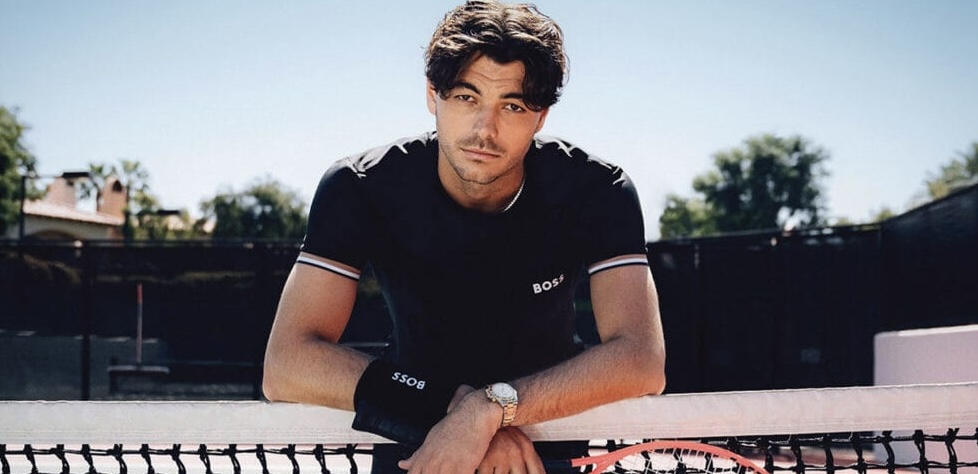With a home court advantage and unshakable belief, Taylor Fritz returns to Indian Wells chasing a second BNP Paribas Open win.
Those who know American tennis star Taylor Fritz best say his secret weapon is his belief. We’re not referring to your usual pro athlete confidence or cockiness. Fritz isn’t one for smack talk. Or much talk at all. It’s all in his facial expressions, his walk, his aura. Fritz often walks onto a court, no matter who he’s about to play, looking like he has already won. He almost seems to be lacking whatever brain synapses create self-doubt.

When he loses, he appears more confused than upset. “Taylor is delusionally optimistic,” his doubles teammate and childhood friend Reilly Opelka has said about him. “Like, totally delusionally optimistic.” Fritz himself once tried to explain it: “[I’m optimistic] to a point where things that shouldn’t be possible, I think I can make happen. I guess I’m playing tricks in my mind.”
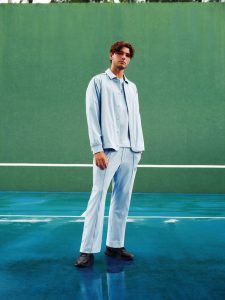
Case in point: When Fritz walked onto the Stadium 1 court at Indian Wells Tennis Garden for the 2022 men’s final against Rafael Nadal, there was quite a bit of wind. The windy season in the California desert has always coincided with tennis season, as nearly half a million fans pile into the second largest outdoor tennis venue in the world every March for the annual BNP Paribas Open.
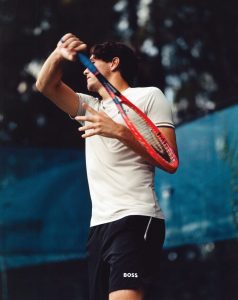
While wind can be a defining feature of this particular stop on the tour (like rain delays at Wimbledon), that afternoon faced gusts of 30 to 40 miles per hour. Cameras sitting higher up on center court captured the oppressive jet-engine roar that batters sensitive microphones. Even down on the court, with 360-degree protection of the 16,100-seat arena, players’ shirts fluttered rapidly.
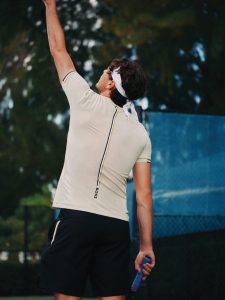
So, there was wind and there was pressure. Fritz was 25 at the time. He grew up playing, training, and pranking friends at the Tennis Garden. His father, Guy Fritz — who also played professionally and coached Taylor until he was about 18 years old — had family in Greater Palm Springs, and they often drove in from their home in San Diego.
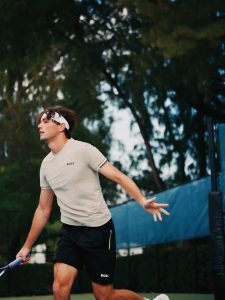
The Indian Wells venue opened in March 2000, when Taylor was 2 years old. “He liked trying to [aim for] the ball machine because it made a nice sound,” Guy remembers. “This was before he could even say the word machine. ‘Hit the ’chine, hit the ’chine,’ he’d say.”
In 2022, it would be fair to say Fritz was playing on home court, and the crowd was behind him. Indian Wells shaped Taylor Fritz, and Fritz was now shaping U.S. Tennis. Whether he liked it or not, Fritz belonged to what some pundits were calling a new golden era of American men’s tennis, giving fans a collective, if somewhat irrational, hope that this generation could end two decades of European dominance.

A Netflix camera crew followed Fritz that year for the docuseries Break Point, which featured Fritz — often with his girlfriend, Instagram influencer and model, Morgan Riddle — as the informal American torch bearer. Netflix likely made this decision at least in part for reasons that have nothing to do with tennis. At 6-foot-5, with smoldering Italian-model eyes, and olive skin, Fritz is the sort of athlete that major lifestyle and fashion brands fall over themselves to sign.
It didn’t seem to bother Netflix, or the crowd, that Fritz was only ranked 23rd at the time. Or, that standing between Fritz and the trophy was legendary Spanish champion Rafael Nadal, who was ranked fifth. Nadal, then 36, was on a 20-game winning streak and seemed unstoppable. Broadly speaking, any player from this new generation of hopefuls, from any country, would have to break through Nadal, Novak Djokovic, and Roger Federer to stake their claim. (Mercifully, Federer retired later that year.) “Coming into Indian Wells, Taylor was not one of the heavy favorites to win,” admits his coach, Michael Russell.
As if the hill didn’t already look too steep to climb, earlier in the day at Indian Wells, Fritz came down on his heel awkwardly during practice. He described it as the worst pain he’s felt in his career, and even he doubted he could carry on. A flurry of texts bounced between coaches and players: “Taylor is out!” But Fritz decided to press forward. Oh, and then there was that wind. It wasn’t exactly the final of Taylor’s boyhood dreams.
However, as Nadal hit his first serve to open the match, the wind, injuries, Netflix producers, rankings, and state of American men’s tennis didn’t exist. The very first volley was like a wake-up call for Nadal. Fritz gave up the point but did so diving toward the net for an impossible save. He believed. Fritz won the first set. Two hours and 20 minutes later, shortly after hitting what was basically a blind backhand to who knows where, Fritz won the final set on a poor return from Nadal.
Taylor Fritz had won his first ATP Masters 1000 title, and he’d done it at Indian Wells — suddenly, he was 15 again. He immediately fell to the court, lying on his back, hands over his face, crying. Fritz became the first American to win the BNP Paribas Open since Andre Agassi in 2001. And he walked off the court $1.2 million richer for it.
In his victory speech, after a nod to childhood hero Nadal, he thanked his family, his girlfriend, his physio, and his coach. “I love coming here,” he said, fighting back tears. “It’s one of those crazy childhood dreams that you think won’t happen.”
Only one word captures Fritz’s reaction in that moment, as he looked at the crowd: disbelief.
Taylor was the sixth most popular baby name in the United States on Oct. 28, 1997, the day Kathy May and Guy Fritz welcomed their son into the world. The couple didn’t have all that much in common except for one thing that would seal their son’s destiny. They were both artists on the tennis court.
May, a Los Angeles native, was a household name among tennis fans in the 1970s. By age 22, she had reached the quarter finals in three separate Grand Slam tournaments (the French Open twice and the U.S. Open) and was ranked 10th in the world. May had been married and divorced twice by the time she met her third husband, Taylor’s father, Guy Fritz. Guy was the brother of six-time Canadian tennis champion Harry Fritz, and he competed on the pro circuit himself. But Guy made his name as a coach, notably helping a young Andre Agassi and being voted coach of the year in 2015 for his work with the U.S. Junior Olympic tennis team. Guy had lived and worked in Palm Springs before he and Kathy were married, as a tennis pro at Oasis Water Park Villas and Cathedral Canyon Country Club.
The couple settled in Rancho Santa Fe. Naturally, their son was learning how to play tennis as soon as he could walk. “Taylor was playing all the time,” Guy says. “He’d play in the morning, have lunch and take a nap, then he’d be right back out.”
Guy did his best to sit back and let his son discover his love of tennis on his own terms. And the proximity to the desert was by design. “It doesn’t rain,” says Guy, whose 97-year-old mother still lives in Palm Springs. “I started Taylor playing tennis young, with the goal of developing him into a pro. So, any time it was raining in San Diego, I’m looking at the weather forecast at Indian Wells, and I’d say, ‘Let’s go.’ He developed close friendships with some of the other players — I think he cared more about seeing his friends than playing tennis. They’d play pingpong, catch lizards, all the things 8-year-old kids do. But I remember telling him, ‘You know, you’re gonna win this tournament someday.’
May recalls, “The first tournament that he ever played in, he was 8 years old, and we were just hoping he could keep score. I was shocked at how focused he was. I mean, for an 8-year-old — I thought, Wow, he’s got amazing concentration. He’s so strong mentally. I’m really impressed with his work ethic and what he’s done. His motivation and determination have been incredible.”
By high school, Fritz excelled in the classroom and on whatever court or field he stepped onto. His relationship with a tennis racket, however, was otherworldly. Fritz has said he started defeating his mom around age 14. “In his sophomore year, he came to me,” Guy recalls. “He says, ‘Dad, I don’t think I have much chance of being a pro at anything except for tennis.”
“My dad asked me if this is what I wanted, and I said it was. So he pushed me very hard,” Fritz says. Since it is nigh on impossible to let your child be a teenager and turn them into a pro athlete, Fritz’s relationship with his father became strained. To make matters worse, Guy and Kathy separated when Fritz was about 18, and he rebelled by choosing the camaraderie and independence of spending time with his U.S. Tennis family over his actual family.
Under the guidance of United States Tennis Association coaches, Taylor had an impressive run of junior tournaments that culminated in two junior Grand Slam quarter finals, reaching the final at the junior French Open. At 18, Taylor turned pro and played in his first senior ITF tournament.
